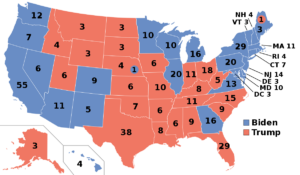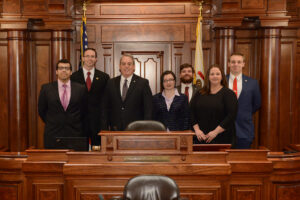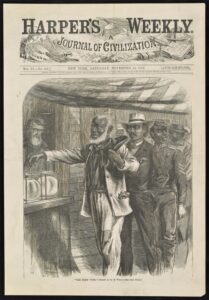Local elections occurred last Tuesday, April 6, in many communities throughout Illinois. Many of the issues on the minds of voters involve the relationship between population distribution and the allocation of political power and public resources. The 2020 season of our program series, The Country and the City: Common Ground in the Prairie State?, consisted of three YouTube programs called “People, Places, and Power,” which examine that relationship from the perspectives of places in Illinois where it seems especially significant: Gallatin County and vicinity, Fulton County and vicinity, and Cook County and vicinity.
Our “People, Places, and Power” programs are part of the “Democracy and the Informed Citizen” initiative administered by the Federation of State Humanities Councils. That initiative seeks to deepen the public’s knowledge and appreciation of the vital connections among democracy, the humanities, journalism, and an informed citizenry. We thank The Andrew W. Mellon Foundation for its generous support of “Democracy and the Informed Citizen” and the Pulitzer Prizes for their partnership. We also thank the Grand Victoria Foundation, the Illinois Arts Council Agency, and the National Endowment for the Humanities.
In the blog post that follows, our program manager for statewide engagement, Matt Meacham, contemplates some of the potential electoral implications of themes discussed in the three “People, Places, and Power” programs. One of those themes is that many residents of rural and urban communities in Illinois sense that they are often forgotten, intentionally or not, by people and institutions in positions of influence in the public and private sectors.
The sense of alienation from the state and federal governments that many rural Illinoisans feel is nothing new. Some of the content of “People, Places, and Power,” suggests that it has intensified in recent years, however.
One of the “many complex reasons” that Molly Parker of The Southern Illinoisan and ProPublica cites for the diminution of southern Illinois’s influence in state-level policymaking in “Gallatin County Edition” is a change in “the way that we were represented in the Illinois house and senate. We used to have three representatives per district. It required more negotiation with Chicago.”

From 1870 to 1980, each state senatorial district had three state representatives, who were elected at large. In that system, called “proportional representation,” all three represented each resident of the entire district. Furthermore, each voter could cast as many as three votes for state representative candidates, potentially allotting A) one to each of three candidates, B) two to one candidate and one to another, or C) all three to a single candidate. This practice was known as “cumulative voting.”
According to various commentators, proportional representation and cumulative voting incentivized bipartisan cooperation and gave representatives from less populous regions more leverage than the present system, in which each state representative district is geographically delineated and served by just one legislator, does. Some contend that the older system was not only more beneficial to rural Illinoisans but also more democratic overall and less prone to polarization than the one currently in place. Public officials from both major parties, including then-state senator Barack Obama and former governor Jim Edgar, have proposed reverting to it, and several organizations, such as FairVote and the Institute for Local Self-Reliance, advocate doing so.
Another change of electoral procedure that eliminated advantages previously possessed by rural voters occurred as a result of the apportionment controversy of the 1960s. Everett Dirksen, a Tazewell County native who represented Illinois in the United States Senate and served as the Senate minority (Republican) leader at the time, played a prominent role in that controversy.

“Being challenged all over the nation were the practices of maintaining traditional legislative district boundaries regardless of their populations or any other considerations for representation,” explains Tiffany White, executive director of the Dirksen Congressional Center in Pekin and an Illinois Humanities Road Scholar, in “Fulton County Edition.” Those challenges culminated in the Supreme Court’s decision in Reynolds v. Sims (1964) stipulating that all state legislative districts be apportioned according to the standard of “one person, one vote.” In other words, district boundaries must be drawn so that districts are as nearly equal in population as possible, ensuring that each legislator in a particular chamber represents approximately the same number of residents.
“In part, the Supreme Court was responding to the overall movement of the nation’s population from the country to the city, a movement under way since the turn of the 20th century. By 1960, there was not a single legislative body in a single state in which there was not at least a two-to-one population disparity between the most and least heavily populated districts,” says White. “As a result, malapportionment had benefited rural areas in state legislative chambers. As people abandoned the farms and countryside, legislators apportioned there on the basis of geography represented fewer and fewer citizens. The result, of course, is that those who remained in those rural areas possessed an overweighted influence.”

In Reynolds v. Sims, the court sought to correct that imbalance. “Legislators represent people, not trees or acres,” wrote Chief Justice Earl Warren. “Diluting the weight of votes because of place of residence impairs basic constitutional rights under the Fourteenth Amendment just as much as invidious discriminations based on race or economic status.”
Senator Dirksen vehemently disagreed. White notes, “As a matter of philosophy and principle, Dirksen favored what was known as the Federal Plan, which provides that one branch of a state’s legislature be based on population and the other on geography.” His primary objection to the ruling, however, was that it “expressly violated the rights of states to determine for themselves how best to constitute their legislatures” and was therefore, in his view, an instance of federal overreach. He commented, “What is really at issue here is not whether so-called equal-population districts are or are not better. Instead, the issue is simply whether the people can continue to make the choice.”
With support from many fellow elected officials, Dirksen led efforts to counteract the court’s decision, eventually taking the unusual and perhaps extreme step of encouraging state legislatures to request a constitutional convention. Several state legislatures did so, and a constitutional convention seemed within the realm of possibility. Dirksen died in 1969, however, and the movement lost its momentum.
The apportionment controversy reflects a recurring conundrum in representative democracy. In one sense, making legislative districts equal in population seems the fairest course of action, because it ensures that every citizen has the same quantity of representation in government. Suppose, however, that residents of Geographic Region A have one set of interests and are significantly outnumbered by residents of Geographic Region B, who have a contrasting set of interests. In a system in which representation is apportioned solely by population, the interests of Region B residents are more likely to influence legislative decision-making than the interests of Region A residents are.
Consequently, apportionment based solely on population can result, at least theoretically, in scenarios in which citizens from less populous regions are persistently disadvantaged as regards the probability of attaining legislative outcomes consistent with their interests. In their most extreme and repressive forms, such scenarios are sometimes described as “tyranny of the majority.”
Which, then, is ultimately fairer: representation based on population alone or representation based on some combination of population and geography? (That question could be interpreted as a particular iteration of a more general question that has occupied countless authors and philosophers, from Plato to Black Hawk: how should fairness be defined in relation to any given social context, and by what criteria should it be assessed?)
That same question underlies the ongoing debate over whether to maintain, modify, or eliminate the Electoral College. For residents of predominantly rural regions within majority-urban states, the Electoral College, in its present form, presents another conundrum. On one hand, because the Electoral College tends to amplify the votes of residents of less populous states, it arguably increases the likelihood that presidential election results will reflect rural perspectives. On the other hand, because the presidential candidate who garners the most popular votes in any given state receives all of that state’s electoral votes, residents of largely rural regions within predominantly urban states are likely to have their votes canceled, in effect, by those of urban dwellers.

Southeastern Illinois College serves just such a region. In “Gallatin County Edition,” students and alumni of the college’s highly successful, award-winning Model Illinois Government team debate the advantages and disadvantages of the Electoral College from the standpoint of rural southeastern Illinois voters, presenting arguments for and against retaining it. An important note: the arguments articulated by the students and alumni do not necessarily correspond to their own personal views.
On one side, Gerard James describes the ongoing implementation of the Electoral College as “a modern-day voter suppression” that “discourages people from wanting to vote.” “The Electoral College has many racist origins,” says Dana Hooven. “More than two centuries after it was designed to empower Southern white voters, the system continues to do exactly that.” Hooven adds, “Now, more than ever, is the time for action to make sure that never again is the loser in an election made President of the United States.”
Jacob Lemon summarizes the opposing view as follows: “The Founders wanted to balance the will of the populace against the risk of tyranny of the majority, in which the voices of the masses could drown out minority interests. Right now, to win the election, presidential candidates need electoral votes from multiple regions, and therefore they build campaign platforms with a national focus, meaning that the winner will actually be serving the needs of the entire nation.”

As the Southeastern Illinois College Model Illinois Government team, Tiffany White, Molly Parker, and many other people featured in “People, Places, and Power” indicate, the electoral implications of the relationship between population distribution and the allocation of power and resources in Illinois are complex and, in some instances, indicative of persistent conundrums in representative democracy. The resources, methods, and spirit of deliberation offered by the humanities can help us to address such conundrums constructively, even if they can never be fully resolved.
Our upcoming Museum on Main Street exhibition from the Smithsonian Institution Traveling Exhibition Service, Voices and Votes: Democracy in America, will provide further opportunities to ponder recurring issues and themes in the evolution of the electoral process and civic participation in the United States:
• “The Great Leap” – the origins of America’s democratic system
• “A Vote, A Voice” – the expansion of the right to vote and challenges related to it, past and present
• “The Machinery of Democracy” – the institutions and systems that facilitate participation in the electoral process
• “Beyond the Ballot” – civic participation, advocacy, and activism beyond the electoral process
• “Creating Citizens” – perspectives on the rights and responsibilities of citizens and their influence upon our complex national identity.

We invite you to view Voices and Votes at any of the following venues, where it will be accompanied by a companion exhibition connecting its subject matter with the host organization’s local history:
• July 17-August 21, 2021: Madison County Historical Society, Edwardsville
• August 28-October 2, 2021: Bryan-Bennett Library, Salem
• October 9-November 13, 2021: Savanna Museum and Cultural Center, Savanna
• November 20-December 25, 2021: Jacksonville Area Museum, Jacksonville
• January 1-February 5, 2022: Vespasian Warner Public Library District, Clinton
• February 12-March 16, 2022: General John A. Logan Museum, Murphysboro.